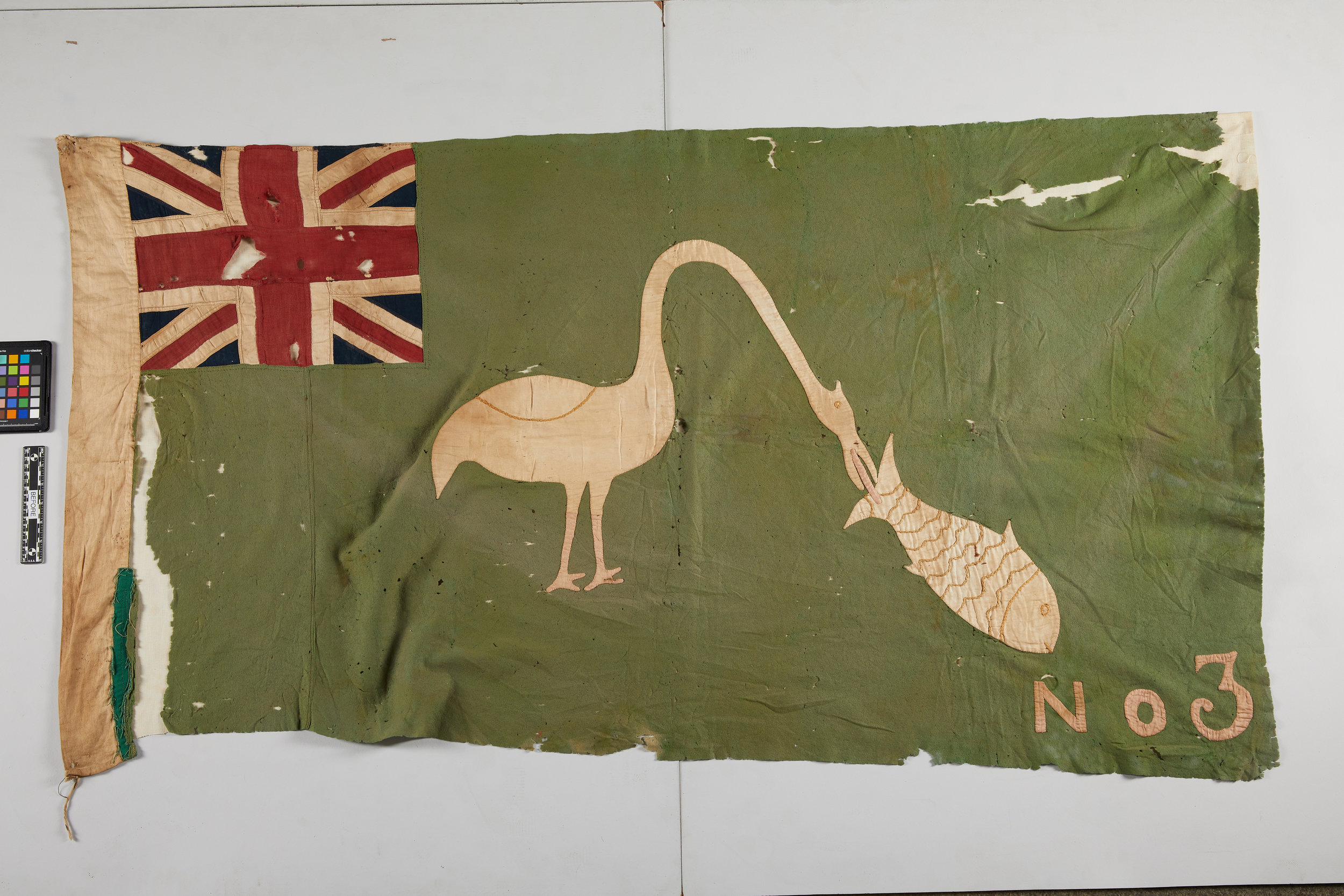There’s nothing more captivating than learning what an artist chooses to collect for himself. Here at The Conservation Center, we’ve been given the opportunity to treat a project from the personal collection of Kerry James Marshall and his wife, actress Cheryl Lynn Bruce: a series of Asafo flags.
“We bought these flags more than twenty years ago because the designs were bold, yet economical. The symbolism was enigmatic; however, we knew the banners were artifacts from Ghana’s colonial past,” said Kerry and Cheryl.
One of the visually stunning flags from the collection, before treatment, 43 x 60.25 inches.
A Fante Asafo Company Shrine, a colorful monument and symbol of community. (Courtesy of the Creative Commons.)
Since the 19th century the Asafo, a part of the Fante tribe located on the southern coast of what is now Ghana, became known for their elaborate flags (frankaa) that were symbols of military companies within communities. They would be flown when they went into battle, fighting together with the British, their colonizers. The flags wouldn’t be flown the entire time but would also be danced in elaborate ceremonies celebrating victory or community. The flags themselves are visually stunning – large, colorful pieces with symbols and shapes that told stories or represented complex social and political issues. On many flags, the Union Jack or British fighter planes are sewn in gorgeous designs. Each company had their own flag and designated uniform colors, though it’s not uncommon for individuals to have their own flags. Asafo flags are made exclusively by men, with younger generations apprenticing to learn the art. The flags were an active art, something used in day to day life, and are still being made, as Gus Casely – Hayford, a British curator, cultural historian and lecturer with Ghanaian roots called them, “a visual metaphor for what community can mean.”
A stunning flag, with some fraying and dye stains, pre-treatment, 36 x 54.5 inches.
After years of use and admiration, the flags were in a state of disrepair. “One or two of them hung in our house, pinned to the wall, from the day we brought them home,” said Kerry and Cheryl. “This wasn’t ideal, given how fragile some of them were, but we liked them so much it seemed worth a little risk. Sooner, or later, we knew they would have to receive a proper treatment. Finally, we brought our flags to The Conservation Center where they were handled with the utmost care.”
This flag features symbols and a human figure, along with bold horizontal stripes, 27.5 x 61.25 inches.
The flags were constructed mainly out of a thin, lightweight cotton, which had become fragile over time. This fragility limited the surface cleaning options – while the pieces would look brighter post – treatment, it was likely that some individual stains would not be completely removed during treatment. Additionally, a few of the flags had considerable dye stains, which were left alone due to the sensitive nature and instability of the pigments and the fabric. Oftentimes, conservation is more focused on preserving the age and history of a piece than any sort of repairing.
An Asafo flag from the collection with large areas of loss, 36 x 65 inches.
First, the pieces were photographed for in-house documentation. The flags were then wet cleaned in small sections with suction, using a mild surfactant. A suction table is a tool that provides a stable surface during treatment. Next, the losses and tears were lined in sympathetically dyed fabric to visually minimize the areas of loss.
Another beautiful flag, before receiving a light cleaning, mounting, and being installed in a vitrine, 53 x 63 inches.
The fringe on the flags was blocked flat and individually sewn to a cotton sheet with linen over the top, mounted to a sealed hardwood stretcher. Sealed materials were a careful choice, to prevent off-gassing which would cause further damage. Kerry and Cheryl requested that the cotton ties of the fringe be tied, then also sewn into the mount, forming a delicate, almost invisible spiderweb of thread on the verso. Client requests and aesthetic decisions are always an integral part of determining a treatment.
The backs of the flags, once mounted to linen and cotton, with delicate strings supporting the textile.
Any areas of damage were lined and secured separately, and areas of loss were lined with sympathetically dyed cotton.
Three women from the Fante tribe, circa 1837.
The next step for the flags is for our Custom Framing and Fabrication Department to create vitrines to encase and preserve them for generations to come. The main contributor to damage in a textile is almost always the environment in which they are stored, including exposure to light and UV rays which could cause deterioration. To avoid this, the flags will be installed into UV blocking Optium – glazed vitrines with museum seams to conservation standards, with an acid free coroplast backing board attached to the reverse for additional protection.
The back of one of the stretched flags, ready for its vitrine.
Kerry and Cheryl said: “After seeing how well all of them were cleaned and mounted by The Conservation Center, we think they look better than they ever did. They look brand new. It’s almost as if they are different objects- more radiant than ever. We like them more now than when we first saw them.”
Our CEO Heather Becker and the entire rest of the staff will certainly miss having the beautiful flags around. We’re honored to have been able to help preserve the cultural and social heritage of the Fante Asafo. “It was such an enjoyable process to meet with Kerry and Cheryl several times,” said Heather, “and to talk through maintaining the character, age, and history of the pieces for years to come.”
Sources:










